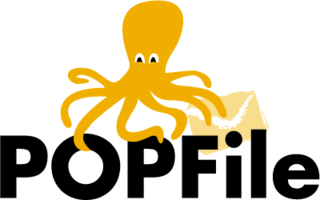A Domain Name System blocklist, Domain Name System-based blackhole list, Domain Name System blacklist (DNSBL) or real-time blackhole list (RBL) is a service for operation of mail servers to perform a check via a Domain Name System (DNS) query whether a sending host's IP address is blacklisted for email spam. Most mail server software can be configured to check such lists, typically rejecting or flagging messages from such sites.
A whitelist or allowlist is a list or register of entities that are being provided a particular privilege, service, mobility, access or recognition. Entities on the list will be accepted, approved and/or recognized. Whitelisting is the reverse of blacklisting, the practice of identifying entities that are denied, unrecognised, or ostracised.
Bogofilter is a mail filter that classifies e-mail as spam or ham (non-spam) by a statistical analysis of the message's header and content (body). The program is able to learn from the user's classifications and corrections. It was originally written by Eric S. Raymond after he read Paul Graham's article "A Plan for Spam" and is now maintained together with a group of contributors by David Relson, Matthias Andree and Greg Louis.
Various anti-spam techniques are used to prevent email spam.

Email spam, also referred to as junk email, spam mail, or simply spam, is unsolicited messages sent in bulk by email (spamming). The name comes from a Monty Python sketch in which the name of the canned pork product Spam is ubiquitous, unavoidable, and repetitive. Email spam has steadily grown since the early 1990s, and by 2014 was estimated to account for around 90% of total email traffic.
Naive Bayes classifiers are a popular statistical technique of e-mail filtering. They typically use bag-of-words features to identify email spam, an approach commonly used in text classification.

POPFile is an abandoned free, open-source, cross-platform mail filter originally written in Perl by John Graham-Cumming and maintained by a team of volunteers. It uses a naive Bayes classifier to filter mail. This allows the filter to "learn" and classify mail according to the user's preferences. Typically it is used to filter spam mail. It can also be used to sort mail into other user defined "buckets" or categories - for example, the user may define a bucket into which work email is sorted.
Email filtering is the processing of email to organize it according to specified criteria. The term can apply to the intervention of human intelligence, but most often refers to the automatic processing of messages at an SMTP server, possibly applying anti-spam techniques. Filtering can be applied to incoming emails as well as to outgoing ones.

Kontact is a personal information manager and groupware software suite developed by KDE. It supports calendars, contacts, notes, to-do lists, news, and email. It offers a number of inter-changeable graphical UIs all built on top of a common core.
The GTUBE is a 68-byte test string used to test anti-spam systems, in particular those based on SpamAssassin. In SpamAssassin, it carries an anti-spam score of 1000 by default, which would be sufficient to trigger any installation.
A challenge–response system is a type of that automatically sends a reply with a challenge to the (alleged) sender of an incoming e-mail. It was originally designed in 1997 by Stan Weatherby, and was called Email Verification. In this reply, the purported sender is asked to perform some action to assure delivery of the original message, which would otherwise not be delivered. The action to perform typically takes relatively little effort to do once, but great effort to perform in large numbers. This effectively filters out spammers. Challenge–response systems only need to send challenges to unknown senders. Senders that have previously performed the challenging action, or who have previously been sent e-mail(s) to, would be automatically receive a challenge.
SURBL is a collection of URI DNSBL lists of Uniform Resource Identifier (URI) hosts, typically web site domains, that appear in unsolicited messages. SURBL can be used to search incoming e-mail message bodies for spam payload links to help evaluate whether the messages are unsolicited. For example, if http://www.example.com is listed, then e-mail messages with a message body containing this URI may be classified as unsolicited. URI DNSBLs differ from prior DNSBLs, which commonly list mail sending IP addresses. SURBL is a specific instance of the general URI DNSBL list type.

ISPConfig is an open source hosting control panel for Linux, licensed under BSD license and developed by the company ISPConfig UG. The ISPConfig project was started in autumn 2005 by Till Brehm from the German company projektfarm GmbH.

Alpine is a free software email client developed at the University of Washington.

hMailServer was a free email server for Windows created by Martin Knafve. It ran as a Windows service and includes administration tools for management and backup. It had support for IMAP, POP3, and SMTP email protocols. It could use external database engines such as MySQL, MS SQL or PostgreSQL, or an internal MS SQL Compact Edition engine to store configuration and index data. The actual email messages were stored on disk in a raw MIME format. As of January 15th, 2022, active support and development were officially halted, although version 5.6 will continue to receive updates for critical bugs.
Backscatter is incorrectly automated bounce messages sent by mail servers, typically as a side effect of incoming spam.

In computing, a blacklist, disallowlist, blocklist, or denylist is a basic access control mechanism that allows through all elements, except those explicitly mentioned. Those items on the list are denied access. The opposite is a whitelist, allowlist, or passlist, in which only items on the list are let through whatever gate is being used. A greylist contains items that are temporarily blocked until an additional step is performed.

Gary Robinson is an American software engineer and mathematician and inventor notable for his mathematical algorithms to fight spam. In addition, he patented a method to use web browser cookies to track consumers across different web sites, allowing marketers to better match advertisements with consumers. The patent was bought by DoubleClick, and then DoubleClick was bought by Google. He is credited as being one of the first to use automated collaborative filtering technologies to turn word-of-mouth recommendations into useful data.
EmailTray is a lightweight email client for the Microsoft Windows operating system. EmailTray was developed by Internet Promotion Agency S.A., a software development d.
SmartScreen is a cloud-based anti-phishing and anti-malware component included in several Microsoft products:








